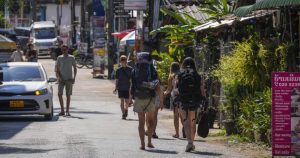Under the spell of Venice’s San Giorgio Maggiore island
This article is part of a new guide to Venice from FT Globetrotter
Across from Saint Mark’s Basin is the tiny island of San Giorgio Maggiore. Ideally positioned to be viewed from the large south-east facing window and balconies of the Doge’s Palace, it called out for a building worthy of such prime real estate.
Measuring around 0.1 sq km (similar in size to Ellis Island in New York), its principal sites can easily be visited in a morning or afternoon, but there is plenty to do, see and eat should you want to linger.
Church of San Giorgio Maggiore
In 1565, the Renaissance architect Andrea Palladio designed a church (his first solo church commission in Venice) for the island that is as magnificent as it is improbable: a shimmering wedding cake of a building that appears to float on water, its dazzling marble façade catching the rays of the setting sun. The hero of EM Forster’s A Passage to India mulled on the perfection of its form, while Turner and Monet are just two of innumerable artists who have attempted to capture its ephemeral beauty on canvas.

Long before the current building came into being, there had been churches on the island, the first dating back to around 790, and in 982 the Benedictine order founded a monastery there. The church (which is actually an abbey) was consecrated to Saint George, hence the name San Giorgio Maggiore to distinguish it from the minor San Giorgio in Alga (another island in the Venetian lagoon).
It remained an important centre of study until the fall of the Serenissima Republic in 1797 and the arrival of Napoleon and his troops. The island was looted, its artworks scattered and in 1806 the monastery was suppressed. However, the Benedictine monks eventually returned to the island and are still present to this day. Although diminutive in number, the monks — who are the only permanent residents on the island and are part of the community of Praglia Abbey (situated just outside Padua) — oversee the running of the church buildings, one of which is their home, and the bell tower. Behind the church they also have a kitchen garden, created in 2012 from a disused football pitch. It is open to visitors if the exhibitions hosted in the church also incorporate the outdoor space.

As well as being an architectural masterpiece, the church is home to several artistic ones. These include Tintoretto’s two monumental works “The Last Supper” and “People of Israel in the Desert” (also known as “The Fall of Manna”), which face each other on the side walls of the chancel. Tintoretto’s final documented work, “The Entombment of Christ”, was painted together with his son Domenico for the altar of the mortuary chapel. Restored by Save Venice in 2020, the painting has remained in situ (bar the odd excursion) since being placed there in 1594.
The church also regularly hosts exhibitions by contemporary artists during the Biennale. Projects are submitted to the Benedictine monks, who with a team evaluate the various proposals. This year, the church is hosting Belgian artist Berlinde De Bruyckere’s “City of Refuge III”, a work that explores contemporary spirituality with wax sculptures of shrouded, faceless archangels that loom over visitors as they walk around the church, while the cast of a fallen tree lies in the sacristy. The exhibition runs until November 24.
The Campanile
The entrance to the campanile is housed at the back of the church. A lift transports you up and down the 63-metre tower. The views from the top are the best in the city — a sweeping panorama that takes in the Giudecca island and canal, the Salute basilica and the entrance to the Grand Canal to your left, Saint Mark’s Square opposite you, and the Riva degli Schiavoni all the way to the Lido on your right. Website; Directions
Fondazione Giorgio Cini

Seen from Venice, the island looks tiny and is dominated by the church facade and campanile. But from the campanile, you get an idea of just how much it holds. Like Dr Who’s Tardis, it is much bigger than it seems from the outside. Adjacent to the church is the erstwhile Benedictine monastery and its verdant cloisters. The ex-monastery now houses the Fondazione Giorgio Cini, a cultural study centre and library for the humanities.


The entrepreneur Count Vittorio Cini created the foundation in 1951 in memory of his son Giorgio, who died in a plane crash. The Fondazione also took over the extensive grounds, full of delights outlined below, which can be visited by booking one of the various tours available.
Borges Labyrinth

As well as a tour of the Fondazione, which boasts a Baldassare Longhena staircase and important works by 16th- and 17th-century Italian artists, you can book a visit to the Borges Labyrinth, a kilometre-long maze situated in the monastery grounds. Designed by the late British labyrinth architect Randoll Coate, it was created by the foundation to commemorate the 25th anniversary of Jorge Luis Borges’ death. Rather than tricking and trapping visitors (Venice has that job covered!), it offers a peaceful meander among the boxwood. Website; Directions
Teatro Verde
The foundation grounds are also home to the Teatro Verde, an amphitheatre designed by the Italian architect Luigi Vietti at the behest of Vittorio Cini and inaugurated in 1954. The Fondazione aims to have the 1,500-capacity theatre fully functioning again once extensive restoration work is complete, although the costs of running the alfresco space are prohibitive.
The theatre is surrounded by dense vegetation and tall trees. (San Giorgio Maggiore was known as the Isola dei Cipressi — Cypress Island — in ancient times, although none of the original cypress wood remains.) Only a glimpse of the lagoon through the trees as you wander through the grounds reminds you that you are on a Venetian island. What the view from the campanile and the island tours show is that Venice, so often decried for its lack of green spaces, is actually full of verdant pockets. Alas, most of them remain concealed behind high walls and are inaccessible to the public. Directions
Vatican Chapels



Another tour takes you in search of the Vatican Chapels. These were originally part of the 2018 Architecture Biennale, in which the Holy See was participating for the first time. Ten chapels by 10 international architects including Norman Foster and Terunobu Fujimori are scattered throughout the woodland grounds behind the church and former monastery. Website; Directions
Le Stanze del Vetro
Once you are out of the church and the Fondazione Cini, following the path alongside the marina chock-full of sailboats leads you to the Stanze del Vetro. A joint project between the Fondazione Giorgio Cini and the Swiss foundation Pentagram Stiftung saw the west wing of a former boarding school converted into an exhibition space predominantly dedicated to 20- and 21st-century glass art, with a particular focus on works produced in Murano. Temporary solo and group exhibitions run throughout the year, including shows by contemporary international artists. Website; Directions
Auditorium ‘Lo Squero’
If music is more your thing, fear not. The foundation has converted an old boatyard into an auditorium where classical and jazz concerts are held regularly throughout the year. Website; Directions
San Giorgio Café


If hiking through the woodland and scaling the dizzying heights of the bell tower have worked up an appetite, the San Giorgio Café provides delicious sustenance and dreamy views. As the only eatery on the island it could hold its punters to ransom, but the prices are honest (at least by Venice standards). The menu is short but features reworkings of Venetian staples such as risi e bisi (rice and split peas). In a classy touch, the wine list includes a sparkling white produced by the Benedictine monks of Praglia Abbey.
Enjoy a meal or simply sip on a spritz while looking across the lagoon towards St Mark’s. Soak up the view and raise your glass to Palladio, the Benedictine monks and the Fondazione Giorgio Cini, who together have conspired to create perhaps the most beautiful island in town. Open Thursday–Tuesday, 10am–7.30pm. Website; Directions
Getting there and opening times
The island can be reached via public transport. Take the number 2 vaporetto to San Giorgio, which is just one boat stop from San Marco Zaccaria. The no 2 line also connects San Giorgio to the Giudecca.
Church of San Giorgio Maggiore: April–October, daily, 9am–7pm; November– March, daily, 8.30am–6pm. Free entry but donations welcome
Campanile: Daily, 10am–1pm and 2pm–6pm. €6
Fondazione Cini: Click here for information and tour times
Le Stanza del Vetro: Thursday–Tuesday, 10am–7pm. Free entry
Have you visited San Giorgio Maggiore island? Tell us about it in the comments below. And follow FT Globetrotter on Instagram at @FTGlobetrotter
Cities with the FT

FT Globetrotter, our insider guides to some of the world’s greatest cities, offers expert advice on eating and drinking, exercise, art and culture — and much more
Find us in Venice, Paris, Rome, London, Tokyo, New York, Frankfurt, Singapore, Hong Kong, Miami, Toronto, Madrid, Melbourne, Copenhagen, Zürich, Milan, Vancouver and Edinburgh
#spell #Venices #San #Giorgio #Maggiore #island








